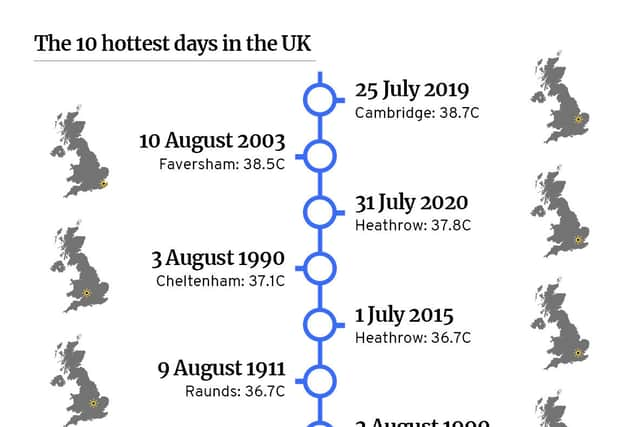When did weather records begin UK? What is the highest temperature on record - and timeline of hottest days
and live on Freeview channel 276
Met Office forecasts suggest temperatures could go as high as 43C in some parts of England, as the UK currently undergoes what experts predict could be a record-breaking heatwave.
But as some parts of England are covered by a red heat health weather warning, some parts of Wales and Scotland are also covered by amber warnings.
Advertisement
Hide AdAdvertisement
Hide AdWith the soaring temperatures and the current weather predicted to be the hottest on record - when did UK records actually begin, what is the hottest day on record and how have temperatures changed over time?
Here’s what you need to know.
When did UK weather records begin?


The Stevenson screen, a shelter that measures weather conditions, was invented in the 1860s, but it was on 29 April 1914, at a meeting of the Meteorological Committee, the Met Office first officially accepted responsibility for custodianship of appropriate public weather records.
Between the end of the First World War and the 1950s, the Met Office expanded and the records it produced were stored across London - with different divisions in charge of different records.
Prior to 1914, several records exist from a range of UK weather stations, but these are limited to small areas or the data is not standardised.
Advertisement
Hide AdAdvertisement
Hide AdHowever, The Central England Temperature (CET) record, which covers the temperature from the south Midlands to Lancashire, has been recording weather data since 1659 and is the longest-running record in the world.
In Northern Ireland, the Armagh Observatory was founded in 1790, and began its meteorological recording in 1974, continuing ever since.
What is the hottest day on record?
Previous to this heatwave, where temperatures hit 39.1C in Charlwood Surrey, the hottest day on record was in Cambridge, on 25 July 2019, where it hit a high of 38.7C.
However, PA news has reported that the Met Office said temperatures in many other places of England had already exceeded the previous record of 38.7C from 2019 by 1pm on Tuesday.
Advertisement
Hide AdAdvertisement
Hide AdAs well as the 40.2C seen at Heathrow, Charlwood in Surrey hit 39.9C, Kew Gardens saw 39.6C and Wisley in Surrey recorded 39.3C.
Chertsey in Surrey and Northolt in west London both saw 39.2C.
In Wales, it reached a high of 37.1C on 18 July 2022, in Flintshire. For Scotland, the hottest day on record was in August 2003, with a temperature of 32.9C and in Northern Ireland, the hottest day on record was on 21 July 2021, in Castlederg, where it hit 31.3C.
However, in this heatwave, Scotland is projected to pass its current record with a prediction of 35C.
How have UK temperatures changed over time?


Advertisement
Hide AdAdvertisement
Hide AdClimate change has a huge impact on the weather the UK is experiencing. According to ClimateChangePost, a news site looking at climate change and adaptation with a focus on Europe, from 1901 to 1999, the average CET temperatures reveal warming of +0.6C over the period.
Warming has greatly occurred from mid-summer to late autumn, with July (+ 0.8°C), August (+ 1.2°C), September (+0.9°C), October (+ 1.2°C) and November (+ 1.3°C) respectively. With the exception of March (+ 1.0°C), the remaining months showed no statistically significant warming over the century.
The CET has increased by about a degree Celsius since the 1970s and eight of the ten warmest years recorded have been since 1990 - with 2006 being the warmest year on record.
Studies have shown that this observed rate of warming cannot be explained by natural climate variations, but is consistent with the response to increasing greenhouse gases and aerosols simulated by the Met Office Hadley Centre climate model.
Advertisement
Hide AdAdvertisement
Hide AdIt is predicted that by 2040, the average annual temperature for the UK is expected to rise by between 0.5 and 1C, depending on the region.
A timeline of the UK’s hottest days
The summer of 1911 held the record as the hottest in the UK for 80 years, as temperatures peaked at 36.7C on 9 August.
But in the summer of 1990, when temperatures hit 37.1C in Cheltenham, a new record was set.
However, in the space of 30 years, the 1911 record has been met and exceeded four times.


Advertisement
Hide AdAdvertisement
Hide AdThe top 10 hottest days in UK history, excluding the current heatwave are:
- 25 July 2019 - Cambridge: 38.7C
- 10 August 2003 - Faversham: 38.5C
- 31 July 2020 - Heathrow: 37.8C
- 3 August 1990 - Cheltenham: 37.1C
- 1 July 2015 - Heathrow: 36.7C
- 9 August 1911 - Raunds: 36.7C
- 2 August 1990 - Worcester: 36.6C
- 19 July 2006 - Wisley: 36.4C
- 7 August 2020 - Heathrow and Kew Gardens: 36.4C
- 6 August 2003 - Gravesend: 36.4C
Met Office meteorologist Annie Shuttleworth told PA on Tuesday (19 July) it is “extraordinarily unusual” to see temperatures in the 30s by the morning rush hour in the UK.
She said: “That’s extraordinarily unusual to see these temperatures in the UK at this time of day”.
She said the high overnight temperatures had led to a very warm start to the day and added: “We’re looking at the maximum temperatures somewhere between 40C-41C, and that’s looking to be across the Lincolnshire and Yorkshire region.”
Comment Guidelines
National World encourages reader discussion on our stories. User feedback, insights and back-and-forth exchanges add a rich layer of context to reporting. Please review our Community Guidelines before commenting.
